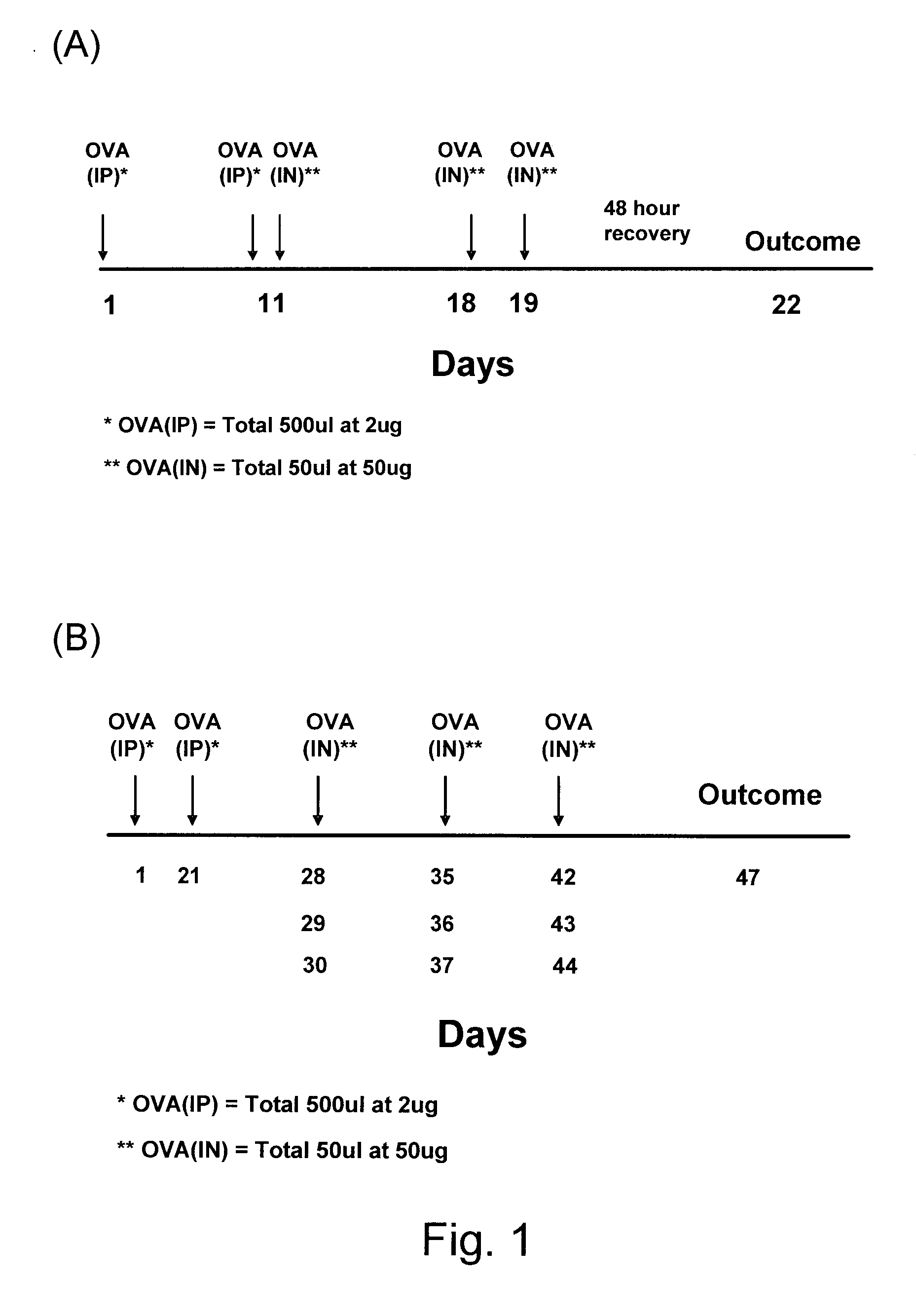Methods of diagnosing asthma
- Summary
- Abstract
- Description
- Claims
- Application Information
AI Technical Summary
Benefits of technology
Problems solved by technology
Method used
Image
Examples
example 1
Detection and Assessment of PTR3 in Asthmatic Mice
[0048]Animals: Female BALB / c mice (7 weeks old) were obtained from the Central Animal Care Services, University of Manitoba (Winnipeg, MB, CA). The experiments were approved by the Animal Care and Use Committee at the University of Manitoba, and the investigators adhered to Canadian Council on Animal Care (CCAC) guidelines for humane treatment of animals. Protocol for sensitization and challenge
[0049]Mice were divided into three groups (three mice per groups 1 and 2; six mice in group 3). Group 1 was the “acute” group. The three mice in Group 1 were sensitized twice (at day 1 and 11) by intraperitoneal injections of 2 μg of ovalbumin (OVA) (Sigma-Aldrich, grade IV) in a volume of 500 μl PBS (FIG. 1(A)). These mice were challenged three times (at days 11, 18 and day 19) by an application of an intranasal droplet of 50 μg OVA in a volume of 50 μl. The Group 1 mice were harvested 3 days after the third challenge i.e., on day 22 (FIG. 1 ...
example 2
Detection and Assessment of PTR3 in Serum Samples from Human Subjects
[0053]Serum samples were collected from three groups of human volunteers. The first group comprised normal healthy donors. The second group comprised non-asthmatics that were exhibiting allergic reactions. The third group comprised individuals that were diagnosed as allergic asthmatics. This study was approved by the Ethics Committee of the Faculty of Medicine, University of Manitoba, Winnipeg, Canada and written informed consent was obtained from each participant. In response to advertisements, individuals 18-45 years old were recruited in each of three groups: allergic individuals with mild asthma, allergic non-asthmatics, and healthy donors. The clinical diagnosis of allergic asthma was determined by: (i) history of asthma symptoms (wheeze, cough, and / or shortness of breath) during the short (6-8 week long) local grass pollen season, controlled with albuterol as needed; (ii) positive epicutaneous test to mixed g...
example 3
Detection and Assessment of PTR3 in Human Airway Smooth Muscle Cell Samples from Human Subjects
[0055]Reagents and Antibodies.
[0056]Recombinant human TNF-α, mouse anti-human pentraxin-3 (PTX3) antibody (Ab), biotinylated goat anti-human PTX3, and recombinant human PTX3 were purchased from R&D Systems®. Monoclonal antibody to PTX3 (MNB1) was purchased from ALEXIS Biochemicals. Rat IgG2b control were from Sigma-Aldrich® (Oakville, Ontario, Canada). Goat anti-rat IgG F(ab′)2 Alexa Fluor® 488 and ProLong® anti-fade were obtained from Molecular Probes® (Eugene, Oreg.). Goat serum and normal human serum were from Cedarlane (Toronto, Ontario, Canada). FBS was from HyClone® (Logan, Utah). DMEM, Ham's F-12, trypsin-EDTA, antibiotics (penicillin, streptomycin), dNTP, SuperScript® reverse transcriptase, and Taq polymerase were from Invitrogen® Life Technologies (Grand Island, N.Y.). PI (Propidium iodide) was from Sigma-Aldrich. The p38 MAPK inhibitor, SB-203580 [4-(4-fluorophenyl)-2-(4-methyl-s...
PUM
| Property | Measurement | Unit |
|---|---|---|
| volume | aaaaa | aaaaa |
| volume | aaaaa | aaaaa |
| diameter | aaaaa | aaaaa |
Abstract
Description
Claims
Application Information
 Login to View More
Login to View More - R&D
- Intellectual Property
- Life Sciences
- Materials
- Tech Scout
- Unparalleled Data Quality
- Higher Quality Content
- 60% Fewer Hallucinations
Browse by: Latest US Patents, China's latest patents, Technical Efficacy Thesaurus, Application Domain, Technology Topic, Popular Technical Reports.
© 2025 PatSnap. All rights reserved.Legal|Privacy policy|Modern Slavery Act Transparency Statement|Sitemap|About US| Contact US: help@patsnap.com



